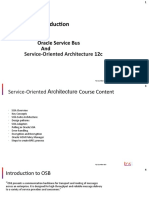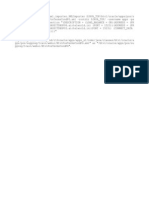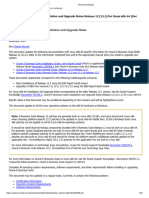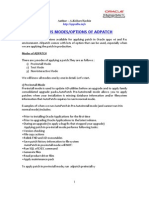OAM EBS OSSO Integration PDF
OAM EBS OSSO Integration PDF
Uploaded by
Ashok SodhaCopyright:
Available Formats
OAM EBS OSSO Integration PDF
OAM EBS OSSO Integration PDF
Uploaded by
Ashok SodhaOriginal Description:
Original Title
Copyright
Available Formats
Share this document
Did you find this document useful?
Is this content inappropriate?
Copyright:
Available Formats
OAM EBS OSSO Integration PDF
OAM EBS OSSO Integration PDF
Uploaded by
Ashok SodhaCopyright:
Available Formats
Oracle Access Manager Integration with Oracle E-Business Suite
ERP Solution is a key and mission critical within most organizations, but it is one of many
applications. As organizations adapting to a web based approach for all their applications, the
need to extend SSO across the enterprise has become a requirement. Organizations are also
looking to standardize and centralize the security management. Demand for access to business
resources continues to increase; organizations require internal applications and information to be
accessible in a secure fashion to an increasing number of employees, customers, and partners.
This Technical white paper discusses how the Oracle access manager Integrates with Oracle E-
Business Suite allowing customer to realize SSO across their entire web-based applications.
Overview of Oracle Access Manager
Oracle Access Manager is a state-of-the-art solution for both centralized identity management and
access control, providing an integrated standards-based solution that delivers; authentication, web
single sign-on, access policy creation and enforcement, user self-registration and self-service,
delegated administration, reporting, and auditing. Oracle Access Managers unique coupling of
access management and identity administration functionality is why it is established as the leading
solution for web access management.
Features
Oracle Access Manager has two major systems: Identity System and Access System.
Identity System allows workflow driven user management and access clearance using
administrative, delegated and self-service functions. The Access System enforces access policies for
web resources using Webgate and AccessGate for legacy systems.
Access Server has following basic components
LDAP Server - To store user, configuration and policy data
Webgate - Webgate is an out-of-the-box access client for enforcing access policy on HTTP-
based resources; hence it is the Access Systems web Policy Enforcement Point or PEP
Access Server - Access Managers Access Server is a standalone software server that
enforces access policies on web and nonweb resources, so it is the Access Systems Policy
Decision Point or PDP.
Policy Manager and Access System Consol e - Access Managers Policy Manager is a
browser-based graphical tool for configuring resources to be protected and well as creating
and managing access policies.
Identity Server - The Identity Server manages identity information about users, groups,
organizations, and other objects.
Webpass - WebPass is the presentation tier of the Identity System.
Accessing E-Business Suite Instances with Single Sign-On
Oracle Application Server, Oracle Internet Directory and Oracle Single Sign-On Server are
required to enable single sign on (SSO) functionality with the E-Business Suite.
For Oracle E-Business Suite Release 12, mod_osso, an Oracle HTTP Server module, is used for
Single Sign-On authentication. It allows the E-Business Suite to register as a partner application to
the Oracle Single Sign-On Server, giving users the ability to access other registered partner
applications with a single credential (for example, a username/password combination). As a
partner application, the E-Business Suite also supports Single Sign-Off.
Oracle AS SSO Server, Oracle Access Manager and E-Business Suite form a chain of trust. Oracle
AS SSO Server delegates authentication to Oracle Access Manager. Implicitly E-Business Suite
trusts the Oracle Access Manager even though E-Business Suite only works with Oracle AS SSO
Server.
Simple Architecture with Oracle AS SSO, E Business Server and Access server Installed on Separate
Server
Internet
Customers
Partners
Supply Chain
Process overview: Integration of Oracle Access Manager, Oracle AS Single Sign-On and Oracle
E-Business Suite
1. A User makes request to access E-Business Suite.E-Business Suite redirects it to Oracle AS
SSO Server for Authentication
2. Webgate, Plug-in running on Oracle AS HTTP Server, intercepts the request. Webgate
requests the security policy from the Access Server to determine if the resource is
protected. When the resource is protected, Webgate prompts the user to authenticate.
3. The credentials entered by the user are validated against the directory for authentication.
4. When authentication is successful, an encrypted Oracle Access Manager single sign-on
cookie is set on the user's browser.
5. After successful authentication, the Access System determines if the user is authorized by
applying policies that have been configured for the resource.
6. Upon successful authorization, the Access System executes the actions that have been
defined in the security policy and sets an HTTP header variable that maps to the OracleAS
10g user ID.
7. The OracleAS SSO Server recognizes the Oracle Access Manager Header Variable,
authenticates the user, and sets the Oracle SSO Cookie and redirects back to the E-Business
Suite.
8. Once redirected back to the E-Business Suite, the E-Business Suite recognizes the Single
Sign-On security tokens and looks up the user's assigned Applications Responsibilities in
the E-Business Suite FND_USER table.
The integration process consists of following major steps:
1. Install Oracle Application Server 10g Enterprise Edition on a standalone server or in a
separate ORACLE_HOMEs on an existing server.
2. Install interoperability patches to integrate the Oracle Application Server 10g Enterprise
Edition server with the E-Business Suite environment.
3. Synchronize user information between the Oracle Application Server 10g Enterprise
Edition server and the E-Business Suite environment
4. Install Oracle Access Manager on a standalone server or on an existing server. Install
webgate on Oracle AS HTTP server.
5. Synchronize user information between the Oracle Application Server 10g Enterprise
Edition server and the Oracle Access Manager User base, if it is different from Oracle AS
user base.
Install OracleAS Identity Management Infrastructure 10g
This task creates the standalone Oracle Application Server 10g Enterprise Edition server
that will be associated with the E-Business Suite server and Oracle Access Server
Run runInstaller on Linux/UNIX or setup.exe on windows.
Select Oracle Application Server Infrastructure 10g
Select Configuration Options:
Sel ect Or acl e I nt er net Di r ect or y, Or acl eAS Di r ect or y I nt egr at i on
and Pr ovi si oni ng, Or acl eAS Si ngl e Si gn- On, Or acl eAS Del egat ed
Admi ni st r at i on Ser vi ces
Test Oracle AS Infrastructure environment
Goto OID DAS (Oracle Internet Directory Delegated Administration Service) and login as
orcladmin.
http://<host_name>.<domain>:<Infrastructure http port number>/oiddas
Install E-Business Suite SSO 10g Integration Patch, If needed. (Integration Patch is included in
R12 Rapid install)
On the E-Business Suite (EBS) application tier set the environment to $FND_TOP and run the
following command
Ex. To provision user from Apps to EBS use ProvOIDtoApps.tmp template.
Chmod 755 $FND_TOP/admin/template/ProvOIDtoApps.tmp
Grant connect , resource to ssosdk
Register EBS with Oracle AS Infrastructure.
$txkrun.pl -script=SetSSOReg -
provtmp=$FND_TOP/admin/template/ProvOIDtoApps.tmp
The script prompts for the following information:
Enter the host name where Oracle AS Infrastructure database is installed: <OAS Infra host>
Enter the Oracle AS Infrastructure database port number : 1521
Enter the Oracle AS Infrastructure database SID: <OID SID>
Enter the LDAP Port on Oracle Internet Directory server: 389
Enter Oracle E-Business apps database user password: <Apps password>
Enter Oracle AS Infrastructure database ORASSO schema password:
Enter Oracle E-Business SYSTEM database user password: <DB Password>
Enter E-Business Suite existing SSOSDK schema password or choose a password to use
with the new SSOSDK schema if the schema does not exist: <SSOSDK Password>
Enter the Oracle Internet Directory Administrator (orcladmin) Bind password: <password>
Enter the password that you would like to register this E-Business instance with:
<password>
Using LDAPUserImport or use the Oracle Internet Directory provisioning solution to move users
into Oracle E-Business Suite.
LinktheeBSAccountswithSSOuser
Set SSO related profile in EBS to enable Single Sign On, setup link option for existing users.
LogintoeBSthroughhttp://<EBSServerName>:<port>/oa_servlets/AppsLogin.EBSredirectstotheOracle
ASSSOpage.
Enter Userid and password and Oracle SSO after authentication redirects back to EBS.
Install Oracle Access Manager and Install Webgate on Oracle AS HTTP Server.
Integrating Oracle Access Manager with Oracle Single Sign On.
Log in to the Policy Manager.
Create Policy Domain and protect following http resource .
1) /sso/auth
2) /pls/orasso/orasso.wwsso_app_admin.ls_login.
Configure default rules with Basic Over LDAP Authentication Scheme.
Click the Actions subtab to configure authentication success or failure actions. Click Add and
configure Return Attributes for Authentication Success with the following information. Click
Save when done
Configure Policies with following information
Resource operations: GET and POST
Resource type: http
Create the Authorization Rule, and allow access to any one. Enable policy domain related sso.
Install and Configure Oracle Single Sign On Authentication Plug-In.
Compile the SSOOblixAuth.java file. The Sample SSOOblixAuth.java file can be found in the
following location
ORCLE_HOME/ sso/ l i b
CompilethefileinLinux,includingORACLE_HOME/ sso/ l i b/ i past ool ki t . j ar intheclasspath.
Usethecommandasshownbelow
ORACLE_HOME/ j dk/ bi n/ j avac - cl asspat h
ORACLE_HOME/ sso/ l i b/ i past ool ki t . j ar : ORACLE_HOME/ l i b/ ser vl et . j ar - d
ORACLE_HOME/ sso/ pl ugi n SSOObl i xAut h. j ava
The above command creates SSOOblixAuth.class and places it in the directory
ORACLE_HOME/ sso/ pl ugi n/ obl i x/ secur i t y/ ssopl ugi n.
Register the J ava class for integration by editing the policy.properties file in the following
location:
Or acl eAS_i nst al l _di r / sso/ conf
Where OracleAS_install_dir is the directory where OracleAS Single Sign-On infrastructure is
installed.
In the OracleAS Single Sign-On policy.properties file, replace the simple authentication plug-in
with the plug-in that you created in the previous steps. In this class, navigate to the line
MediumSecurity_AuthPlugin:
Medi umSecur i t y_Aut hPl ugi n = or acl e. secur i t y. sso. ser ver . aut h. SSOSer ver Aut h
Comment out the existing line and add a new line to register your J ava class, as follows:
Medi umSecur i t y_Aut hPl ugi n = obl i x. secur i t y. ssopl ugi n. SSOObl i xAut h
When editing policy.properties, take care not to insert blank space at the end of a line.
Save the file.
Restart the single sign-on middle tier, and restart the OC4J instance OC4J _SECURITY to have
your changes to take effect:
Test the integrated system. Log on to the EBS.
Harish R Jangada
Harish.Jangada@identris.com
Identris
499 Thornall Street
Edison,NJ
You might also like
- SOA 12c Installation Guide PDFDocument38 pagesSOA 12c Installation Guide PDFNTGDNNo ratings yet
- ODI 12C Installation Step by Step PART 1Document4 pagesODI 12C Installation Step by Step PART 1m_saki6665803No ratings yet
- OU - 1Z0 1067 OCI Operations Associate 2020 Exam Study GuideDocument9 pagesOU - 1Z0 1067 OCI Operations Associate 2020 Exam Study Guidejoseph michael0% (1)
- Charts in Oracle Visual BuilderDocument5 pagesCharts in Oracle Visual BuilderVijay guptaNo ratings yet
- Adf With EbsDocument129 pagesAdf With EbsMohinder SinghNo ratings yet
- (OBIEE11g) Integrating Oracle Business Intelligence Applications With Oracle E-Business Suite - Oracle Bi SolutionsDocument11 pages(OBIEE11g) Integrating Oracle Business Intelligence Applications With Oracle E-Business Suite - Oracle Bi SolutionsVenkatesh Ramiya Krishna MoorthyNo ratings yet
- Oracle EBS Integration OAM11g OID11g Sample ChapterDocument12 pagesOracle EBS Integration OAM11g OID11g Sample ChapterrkvenkiNo ratings yet
- M 01 EBS OAM Architecture Concepts Ed1Document24 pagesM 01 EBS OAM Architecture Concepts Ed1Khansex ShaikNo ratings yet
- Jenny - Oracle ECCDocument4 pagesJenny - Oracle ECCMadhav GarikapatiNo ratings yet
- Virtualized ISO Imaging On ODADocument21 pagesVirtualized ISO Imaging On ODAmiguelangel.mirandarios1109No ratings yet
- OU - 1Z0 931 Autonomous Database Specialist 2019 Exam Prep GuideDocument9 pagesOU - 1Z0 931 Autonomous Database Specialist 2019 Exam Prep GuidecssundarNo ratings yet
- Autonomous Transaction ProcessingDocument179 pagesAutonomous Transaction ProcessingSarojiniBalakrishnanNo ratings yet
- Using Oracle Autonomous Transaction PDFDocument161 pagesUsing Oracle Autonomous Transaction PDFDeepak PatilNo ratings yet
- Web Logic ArchitectureDocument5 pagesWeb Logic ArchitecturetalupurumNo ratings yet
- Oracle CloudDocument57 pagesOracle Cloudsoma3tNo ratings yet
- ORACLE 12.1 Financials ImplementationDocument424 pagesORACLE 12.1 Financials ImplementationAbdulqayum SattigeriNo ratings yet
- Oracle EBS 12.2.7 Rohan TESTDocument39 pagesOracle EBS 12.2.7 Rohan TESTRohan JainNo ratings yet
- Oracle Ebs InstallationDocument22 pagesOracle Ebs InstallationMr. JalilNo ratings yet
- Making The Move From Oracle Warehouse Builder To Oracle Data Integrator 12cDocument34 pagesMaking The Move From Oracle Warehouse Builder To Oracle Data Integrator 12calejandromoraNo ratings yet
- IsgDocument18 pagesIsgashibekNo ratings yet
- Oracle SOA Suite 12c Ebook 2014Document20 pagesOracle SOA Suite 12c Ebook 2014michael2pontes100% (1)
- Oracle Apex API ReferenceDocument1,019 pagesOracle Apex API ReferenceberryguoNo ratings yet
- Asynchronous Web Services With Oracle SOA SuiteDocument45 pagesAsynchronous Web Services With Oracle SOA SuiteshrikantNo ratings yet
- 12.2.7 OafDocument1,626 pages12.2.7 OafHasibul Hassan50% (2)
- Oracle Access ManagerDocument22 pagesOracle Access ManageritshezzNo ratings yet
- Oracle ADFDocument1,686 pagesOracle ADFpawan_7214100% (2)
- 17 .Using REST Services To Manage WebLogic ServerDocument20 pages17 .Using REST Services To Manage WebLogic ServerAddiNo ratings yet
- Integrating Oracle E-Business Suite Release 12.2 With Oracle Access Manager 11gR2 (11.1.2) Using Oracle E-Business Suite AccessGateDocument25 pagesIntegrating Oracle E-Business Suite Release 12.2 With Oracle Access Manager 11gR2 (11.1.2) Using Oracle E-Business Suite AccessGateTsdfsd YfgdfgNo ratings yet
- Introduction To Oracle Access ManagerDocument5 pagesIntroduction To Oracle Access Managersanjayid1980No ratings yet
- Configuring Web Application Services and Managing OHSDocument52 pagesConfiguring Web Application Services and Managing OHSsobeth100% (1)
- Oracle Fusion Middleware 11g: Build Applications With Oracle FormsDocument18 pagesOracle Fusion Middleware 11g: Build Applications With Oracle FormskamuniasNo ratings yet
- Complete Installation and Configuration of Oracle Data IntegratorDocument33 pagesComplete Installation and Configuration of Oracle Data IntegratorDinesh ReddyNo ratings yet
- SOA Enterprise Deployment GuideDocument450 pagesSOA Enterprise Deployment GuidegisharoyNo ratings yet
- OAFvsADF WhitePaperDocument7 pagesOAFvsADF WhitePaperSanjay PriyadarshiNo ratings yet
- Improve Security in Oracle EBS and Prepare For Fusion Cloud Collaborate 15 WPDocument16 pagesImprove Security in Oracle EBS and Prepare For Fusion Cloud Collaborate 15 WPShaik MahamoodNo ratings yet
- HCM92ERDInstructions FinalDocument8 pagesHCM92ERDInstructions FinalmanedeepNo ratings yet
- Implementing Aia Osb 11g 349389Document114 pagesImplementing Aia Osb 11g 349389ptameb1No ratings yet
- Oracle Service Bus and 12cDocument33 pagesOracle Service Bus and 12cShankarNo ratings yet
- Apex-Overview 23.1Document73 pagesApex-Overview 23.1Azam UddinNo ratings yet
- JPX ImporterDocument1 pageJPX Importerangra11No ratings yet
- Ebs Obiee PDFDocument11 pagesEbs Obiee PDFAnil RawatNo ratings yet
- VBCS Notes (Learning Path)Document1 pageVBCS Notes (Learning Path)Moha4740% (2)
- Upgrading To Release 12.2 Within Oracle E-Business Suite Upgrade Guide 12.0 and 12.1 To 12.2-E48839Document112 pagesUpgrading To Release 12.2 Within Oracle E-Business Suite Upgrade Guide 12.0 and 12.1 To 12.2-E48839Sumit PawarNo ratings yet
- Sample Resume On OAFDocument3 pagesSample Resume On OAFSharret Sha100% (1)
- Oracle Fusion Middleware Interview Questions: EditionDocument16 pagesOracle Fusion Middleware Interview Questions: EditionSumit S Das100% (1)
- Oracle Access Manager High Availability Training ClassDocument38 pagesOracle Access Manager High Availability Training ClasscheenuNo ratings yet
- Oracle Fusion OIC Tech Leads IT Brouchre PDFDocument24 pagesOracle Fusion OIC Tech Leads IT Brouchre PDFhackhonerNo ratings yet
- Oracle Application Server Web Services - AdvancedDocument336 pagesOracle Application Server Web Services - AdvancedscribmasmNo ratings yet
- EBS Reports and Dashboards For The People and by The People WPDocument10 pagesEBS Reports and Dashboards For The People and by The People WPMarcioCarvalhoNo ratings yet
- D60471GC10 Ag PDFDocument238 pagesD60471GC10 Ag PDFSonaliNo ratings yet
- ODI 12c - SCMDocument45 pagesODI 12c - SCMAsad HussainNo ratings yet
- Oracle® E-Business Suite: Setup Guide Release 12.2Document636 pagesOracle® E-Business Suite: Setup Guide Release 12.2subhash221103No ratings yet
- Oracle E-Business Suite Installation R122Document32 pagesOracle E-Business Suite Installation R122Mohsin ShariffNo ratings yet
- 1Z0 337 UnlockedDocument31 pages1Z0 337 UnlockedDimitris AlyfantisNo ratings yet
- Oracle SOA BPEL Process Manager 11gR1 A Hands-on TutorialFrom EverandOracle SOA BPEL Process Manager 11gR1 A Hands-on TutorialRating: 5 out of 5 stars5/5 (1)
- Pro Oracle SQL Development: Best Practices for Writing Advanced QueriesFrom EverandPro Oracle SQL Development: Best Practices for Writing Advanced QueriesNo ratings yet
- Oracle Solaris 11 System Virtualization Complete Self-Assessment GuideFrom EverandOracle Solaris 11 System Virtualization Complete Self-Assessment GuideNo ratings yet
- The Business Analyst's Guide to Oracle Hyperion Interactive Reporting 11From EverandThe Business Analyst's Guide to Oracle Hyperion Interactive Reporting 11Rating: 5 out of 5 stars5/5 (1)
- 12 More Things About Oracle 12cDocument88 pages12 More Things About Oracle 12cAshok SodhaNo ratings yet
- AST White Paper-EBS-OBIEE 11g IntegrationDocument41 pagesAST White Paper-EBS-OBIEE 11g IntegrationAshok SodhaNo ratings yet
- Online Patching Enablement - Readiness ReportsDocument18 pagesOnline Patching Enablement - Readiness ReportsAshok SodhaNo ratings yet
- WLS New FarturesDocument30 pagesWLS New FarturesAshok SodhaNo ratings yet
- Lost of System Datafile Here System - DBF Datafile of Running Database Is RemovedDocument6 pagesLost of System Datafile Here System - DBF Datafile of Running Database Is RemovedAshok SodhaNo ratings yet
- SSL in Oracle Apps 11iDocument40 pagesSSL in Oracle Apps 11iAshok Sodha100% (1)
- Adpatch ModesDocument7 pagesAdpatch ModesShaista NaumanNo ratings yet


































































